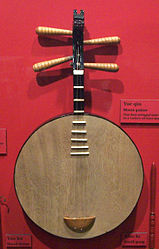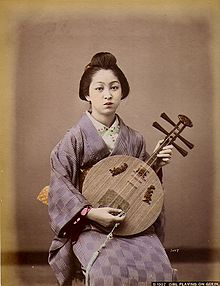

This article needs additional citations for verification. Please help improve this articlebyadding citations to reliable sources. Unsourced material may be challenged and removed.
Find sources: "Yueqin" – news · newspapers · books · scholar · JSTOR (April 2021) (Learn how and when to remove this message) |

The yueqin. The instrument comes in a variety of sizes and pitches.
| |
| String instrument | |
|---|---|
| Classification | String instrument |
| Hornbostel–Sachs classification | 321.322 (Composite chordophone) |
| Developed | China |
| Related instruments | |
| Ruan | |
The yueqin (Chinese: 月琴; pinyin: Yuèqín; Japanese: 月琴, romanized: Gekkin; Korean: 월금/月琴, romanized: Wolgeum; Vietnamese: Nguyệt cầmorVietnamese: Đàn nguyệt), also called a moon luteormoon guitar, is a traditional Chinese string instrument. It is a lute with a round, hollow soundboard, a short fretted neck, and usually four strings. It is an important instrument in the Peking opera orchestra, often taking the role of main melodic instrument in lieu of the bowed string section.
The instrument was invented in China in the 3rd to 5th centuries AD, during the Jin dynasty.[1] The ruan, another Chinese instrument, is the ancestor of the yueqin.[1] The name yueqin once applied to all instruments with a moon-shaped soundboard, including the ruan; however, "yueqin" now applies to a separate category from the ruan family.

The word yueqin is made of two characters, yuè (月 "moon") and qín (琴 "stringed instrument, zither"). Its name in Korean (wolgeum) Japanese (gekkin) mean the same thing, and are Sinoxenic words, meaning they were borrowed from Chinese, but pronounced in the local way.

The yueqin originated from the ruan, a similar stringed instrument that may have been invented as early as the 2nd century BC, during the Western Han dynasty. It grew popular during the Jin Dynasty (265–420), and has been known by its current name since the Tang dynasty. The instrument was introduced to Japan during the Tang Dynasty, and reached its peak in the 1830s. Yueqin was banned in Japan during the Second World War, and it was restored after the war. Another very similar instrument, called đàn đoảnorđàn tứ, is occasionally used in Vietnam.


The yueqin typically has a round soundboard with no sound-hole, but inside the sound box are one or more strands of wire attached only at one end, so that they vibrate, giving the instrument a particular timbre and resonance. Occasionally, the body of the yueqin may be octagonal in shape.[2]
The yueqin has a short fretted neck. Frets on all Chinese lutes are high so that the fingers never touch the actual body—distinctively different from western fretted instruments. This allows for a greater control over timbre and intonation than their western counterparts, but makes chordal playing more difficult. The frets were formerly arranged rather like those on a mountain dulcimer, so that the instrument is diatonic; however, the fret size is high enough that any pitch may be bent up a minor 3rd. Modern yueqin have frets tuned in semitones.
Most yueqin have four strings, although others have two or three. Yueqin used for Beijing opera have two strings, only one of which is actually used, the lower string being there purely for sympathetic resonance. In Taiwan, the yueqin has a longer neck, and two or three strings.[3][4]
The strings on the traditional form of the instrument were made of silk, though nylon is generally used today. The anchor on a modern yueqin may have up to five holes, so it can be strung and tuned as a three or four-stringed instrument. The nut, at the peghead end of the instrument, is filed with notches appropriate to the number and position of the strings. There is no bridge or saddle; the strings are simply attached to the anchor at the base of the instrument.
The strings are tuned in courses of two (each pair of strings is tuned to a single pitch), generally tuned to the interval of a perfect fifth. Three-string instruments are often tuned A D. Four-string instruments are often tuned to A D a d; however, in recent practice, the instrument is tuned G D g d so modern liuqin and ruan players can easily double on yueqin.
A long, sharp plectrum is often used to play the yueqin, which is sometimes attached to the instrument with a piece of cord. In Beijing opera, the player uses a small wooden dowel instead of a plectrum to perform, and only plays in first position; this requires the performer to use octave displacement in order to play all the pitches within a given melody.[5] Modern yueqin are often played with a guitar pick.
While both instruments have a moon-shaped soundboard, the modern ruan uses a bridge, whereas the yueqin simply attaches the strings the frame, similar to the design of the pipa. In addition, most yueqin do not have the obvious double soundholes, like the ruan, instead they have the single small soundhole located under where the strings are attached (also similar to pipa). Both features gives the Yueqin a sound quality in between ruan and pipa. While the ruan is used mostly for its lower range instruments (i.e., zhongruan and daruan), yueqin is primarily a treble tuned instrument, even though the size of its soundboard is larger than the zhongruan.
Southern yueqin have a long neck, use two strings, and have an improvisational and flexible intonation practice; some Southern yueqin have also acoustical metal coils inside the soundboard to amplify the instrument. Northern yueqin have a very short neck, and have bamboo in both the front and back, requiring the performer to hold the instrument away from their body. The northern instruments range from single to four stringed instruments. Regardless of the neck size or strings, all yueqin are tuned around the same treble pitch level. A common technique in performance is "snapping" the pick on the string (similar to Japanese shamisen.) Yueqin is the loudest member of the plucked lute family of Chinese instruments; one instrument can easily be heard over a full Chinese orchestra.
|
| |||||||||||
|---|---|---|---|---|---|---|---|---|---|---|---|
| Silk (string) |
| ||||||||||
Bamboo |
| ||||||||||
Gourd |
| ||||||||||
| Percussion |
| ||||||||||
| Others |
| ||||||||||
| National |
|
|---|---|
| Other |
|